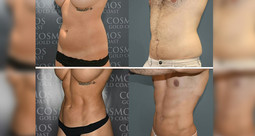Liposuction is a surgical cosmetic procedure to remove deposits of fat from areas like the abdomen, inner and outer thighs, and sides. While it’s designed to target excess fat, many people wonder how their skin will adjust after the surgery, and whether removing fat will leave them with excess skin.
The Role of Skin Quality in Liposuction Results
The skin’s ability to adapt after liposuction is influenced by individual factors, and results can vary from person to person. Skin typically contracts to some degree during the healing process, but this depends largely on its elasticity.
Those with good skin elasticity often experience a smoother outcome, while individuals with reduced elasticity may notice some skin irregularities after fat removal. Several factors can affect skin elasticity, including:
- Genetics
- Age
- Sun exposure
- Stress
- Weight fluctuations
- Dehydration
- Nutrition
Visible changes like stretch marks, uneven texture, or reduced firmness may indicate a decrease in skin elasticity. However, it’s important to remember that the quality of your skin can improve over time as your body heals and swelling diminishes.
How Surgical Techniques Can Influence Skin Quality
Surgical techniques can greatly influencer how your skin responds after liposuction. Techniques used during Vaser liposuction specifically can help support the skin’s ability to contract. Compression garments are also a key part of the recovery process, helping to stimulate the healing response and contribute to the final outcome.
At Cosmos Clinic, advanced technologies like Vaser Liposuction and Renuvion/J-Plasma are incorporated into treatments to assist with addressing skin concerns.
- Vaser Liposuction: Uses ultrasound technology to precisely target fat cells while helping preserve the surrounding tissues, potentially encouraging skin retraction.
- Renuvion: Combines plasma and radiofrequency energy to support the underlying skin structure. The device delivers heat to the subdermal layers, stimulating collagen production and improving the appearance of skin over time.
These methods can be especially beneficial for areas like the arms, thighs, and abdomen, where skin may have reduced elasticity. It’s important to discuss these options during your consultation to determine the most suitable approach for your needs.
Addressing Excess Skin After Liposuction
For individuals with significant fat removal or minimal skin elasticity prior to surgery, there may be some excess skin post-procedure. In such cases, additional treatments may be considered:
- Abdominoplasty: For removing large amounts of excess skin from the abdomen after significant fat removal. This procedure eliminates overhanging skin rather than tightening it.
- Brazilian Butt Lift (BBL): For individuals with excess skin in the lower body, combining liposuction with a BBL can add firmness to the area.
Long-Term Outcomes
The final results of liposuction may take months to fully appear as your body heals and swelling reduces. Skin often continues to adjust and improve for months, sometimes even years, following the procedure.
If skin concerns persist, there are options available to address them. Discussing your goals and skin quality during your consultation is essential to developing the right treatment plan.
To llearn more about liposuction procedures, contact the Cosmos Clinic team on 1300-138-797 or via [email protected].






